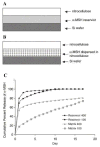Approaches to neural tissue engineering using scaffolds for drug delivery
- PMID: 17482308
- PMCID: PMC1976339
- DOI: 10.1016/j.addr.2007.03.014
Approaches to neural tissue engineering using scaffolds for drug delivery
Abstract
This review seeks to give an overview of the current approaches to drug delivery from scaffolds for neural tissue engineering applications. The challenges presented by attempting to replicate the three types of nervous tissue (brain, spinal cord, and peripheral nerve) are summarized. Potential scaffold materials (both synthetic and natural) and target drugs are discussed with the benefits and drawbacks given. Finally, common methods of drug delivery, including degradable/diffusion-based delivery systems, affinity-based delivery systems, immobilized drug delivery systems, and electrically controlled drug delivery systems, are examined and critiqued. Based on the current body of work, suggestions for future directions of research in the field of neural tissue engineering are presented.
Figures





Similar articles
-
Matrices and scaffolds for drug delivery in dental, oral and craniofacial tissue engineering.Adv Drug Deliv Rev. 2007 May 30;59(4-5):308-24. doi: 10.1016/j.addr.2007.03.019. Epub 2007 Apr 18. Adv Drug Deliv Rev. 2007. PMID: 17499385 Free PMC article. Review.
-
Neural tissue engineering: strategies for repair and regeneration.Annu Rev Biomed Eng. 2003;5:293-347. doi: 10.1146/annurev.bioeng.5.011303.120731. Annu Rev Biomed Eng. 2003. PMID: 14527315 Review.
-
Scaffold-based Drug Delivery for Cartilage Tissue Regeneration.Curr Pharm Des. 2015;21(15):1979-90. doi: 10.2174/1381612821666150302152836. Curr Pharm Des. 2015. PMID: 25732662 Review.
-
Recent advances in biomaterials for tissue engineering and controlled drug delivery.Curr Pharm Biotechnol. 2015;16(7):635-45. doi: 10.2174/138920101607150427112208. Curr Pharm Biotechnol. 2015. PMID: 25934973 Review.
-
The effect of controlled growth factor delivery on embryonic stem cell differentiation inside fibrin scaffolds.Stem Cell Res. 2008 Sep;1(3):205-18. doi: 10.1016/j.scr.2008.05.006. Epub 2008 Jun 10. Stem Cell Res. 2008. PMID: 19383401 Free PMC article.
Cited by
-
Stem cells for spinal cord injury: Strategies to inform differentiation and transplantation.Biotechnol Bioeng. 2017 Feb;114(2):245-259. doi: 10.1002/bit.26074. Epub 2016 Sep 21. Biotechnol Bioeng. 2017. PMID: 27531038 Free PMC article. Review.
-
Improvements in biomaterial matrices for neural precursor cell transplantation.Mol Cell Ther. 2014 Jul 1;2:19. doi: 10.1186/2052-8426-2-19. eCollection 2014. Mol Cell Ther. 2014. PMID: 26056586 Free PMC article. Review.
-
MiRNA influences in mesenchymal stem cell commitment to neuroblast lineage development.Noncoding RNA Res. 2018 Nov 15;3(4):232-242. doi: 10.1016/j.ncrna.2018.11.002. eCollection 2018 Dec. Noncoding RNA Res. 2018. PMID: 30533571 Free PMC article.
-
The impact of prolapse mesh on vaginal smooth muscle structure and function.BJOG. 2016 Jun;123(7):1076-85. doi: 10.1111/1471-0528.13514. Epub 2015 Aug 20. BJOG. 2016. PMID: 26301457 Free PMC article.
-
Strategies for regeneration of components of nervous system: scaffolds, cells and biomolecules.Regen Biomater. 2015 Mar;2(1):31-45. doi: 10.1093/rb/rbu017. Epub 2015 Jan 13. Regen Biomater. 2015. PMID: 26813399 Free PMC article. Review.
References
-
- Sosin DM, Sniezek JE, Thurman DJ. Incidence of mild and moderate brain injury in the United States, 1991. Brain Inj. 1996;10(1):47–54. - PubMed
-
- Hebert LE, Scherr PA, Bienias JL, Bennett DA, Evans DA. Alzheimer disease in the US population: prevalence estimates using the 2000 census. Arch Neurol. 2003;60(8):1119–22. - PubMed
-
-
Fact Sheet about Parkinson’s Disease: Parkinson’s Disease Foundation; 2006.
-
-
-
National Spinal Cord Injury Statistical Center Fact Sheet.: National Spinal Cord Injury Center; June 2006.
-
-
- Noble J, Munro CA, Prasad VS, Midha R. Analysis of upper and lower extremity peripheral nerve injuries in a population of patients with multiple injuries. J Trauma. 1998;45(1):116–22. - PubMed
Publication types
MeSH terms
Substances
Grants and funding
LinkOut - more resources
Full Text Sources
Other Literature Sources
Medical

